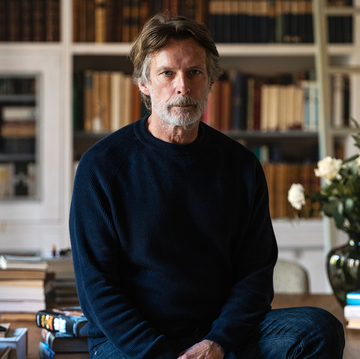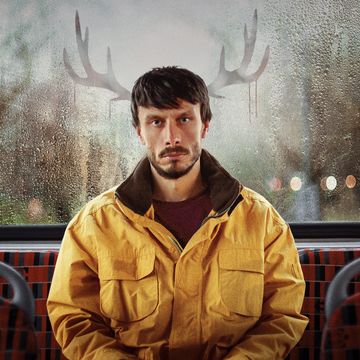Half a century after his death, Che Guevara is bigger than ever. The revolutionary immortalised in Alberto Korda's brooding portrait, which has been called the most famous photograph ever taken, is the poster boy for the free-associating, underground protest movements which are roiling politics and social media around the globe. But could this anti-capitalist firebrand be any relation of one of the great advertising legends of our time, beloved of the mad men for his matchless capacity to shift everything from T-shirts to baby-gros, who also trades under the brand name Che Guevara?
Guerrillero Heroico, as his likeness is dubbed, is so contemporary it appears to anticipate the selfie, at least four decades avant la lettre (and with all due apologies to the maestro photographer). And staking a claim to it are some of the most powerful and apparently conflicting forces at work in the world today. Or to put it another way, the revolution will be merchandised.
It's almost trite to say that Korda's study is an iconic image, except that for once the term may be applied literally, or very nearly. It's helped to confirm Guevara's secular sainthood among his admirers, as an altruistic freedom fighter who toppled a corrupt dictator in Cuba, only to renounce the trappings of power for himself and devote the remainder of his brief life to the struggle for liberation in Africa and Latin America. That said, many others see him in an altogether different light, as a bloodthirsty killer who presided over show trials of the overthrown old order in Havana, and as a flagrantly unreconstructed homophobe.
Originally snapped on 5 March 1960, Korda's Che — now much meme'd, gif'd, Whatsapp'd — multiplies and multiplies. Meanwhile, the man himself, who was cornered in Bolivia by local troops and CIA agents and shot dead in 1967, is a greatly diminished figure these days. As The New Yorker correspondent Jon Lee Anderson reported in his exhaustive biography, the Bolivian military cut off Che's hands, perhaps to prove identification, perhaps out of bloody-minded spite, and buried him at the bottom of a mass grave, his late comrades heaved in on top of him. His remains were later exhumed and flown to Cuba, the scene of his greatest triumph, the revolution of 1959, in which the olive-clad, cigar-munching Che and Fidel Castro swept the American-backed President Fulgencio Batista from Havana.
Che's bones are interred in the city of Santa Clara, where the Cuban revolutionaries won a famous battle on the road to victory. These hallowed relics were still exerting a sufficient other-worldly frisson to throw Castro himself off his stride a little more than a decade ago. A supposed split between Fidel and Che, which led to the latter leaving Havana in 1965 to foment revolution abroad, commands almost as much pop culture scrutiny as the rift between Lennon and McCartney. Cubans of a superstitious bent (which would be most of them) believe it was bad karma, a payback of Santeria (Cuban voodoo), when Castro fell over and took sick as he declaimed a eulogy over Che's tomb. It was the beginning of El Commandante's long withdrawal from public life, culminating in his death last November at the age of 90.
Dead at 39, Che was young enough to leave a good-looking corpse, and although the Bolivians denied him that in person, he is eternally young and striking and smoulderingly dangerous in his photographic contact sheets. And yet for all the totemic power of Korda's icon, its singularity, it is also in some ways a curiously debased coinage. We're told that one of the many boons of digital reproduction is that there's no loss of quality, of definition — the umpteenth iteration is as pin-sharp as the original negative. But I wonder if that's quite true. Doesn't saturation diminish impact? (Personally, I've always much preferred the same photographer's joyously unguarded stills of Guevara and Castro sharing nine holes of pitch and putt, or casting lugworm for marlin in a fishing boat off the shimmering promenade of the Malecón.)
When Che served as president of the National Bank of Cuba, and his signature somewhat improbably appeared on the country's banknotes, you can only imagine how faded it became after the pesos were run off the humid Havana presses in their grubby, inflationary wads. Has the same thing happened to Korda's prototype emoji (the beret, the badge, the 1,000-yard stare)? In short, what is the currency of a Che in 2017? In search of an answer to that, I went looking for what I could find of him, though not among the ceaselessly replicating lookalikes of Korda's darkroom. No, I was on the trail of the real, the mortal Che, his own flesh and blood, sanctified or otherwise.
Ernesto Guevara Lynch was born in Rosario, Argentina, on 14 June 1928, the eldest child of middle-class parents. His mother was an intellectual, something of a bohemian, his father a would-be schemer but in practice more of a dreamer. The young Ernesto played rugby, which, like polo, is a sport associated with the anglophile elite of Argentinian society, and he studied to be a doctor. It was hardly the background of a Marxist revolutionary, but it was on Che's now-well-known motorcycle journeys through South America as a young man that his political views were formed by the poverty and hardship he saw at first hand. The family later moved to the capital, Buenos Aires, the great, urbane, "Paris of the South", and it was there that I tracked down Che's kid brother, Juan Martin Guevara, now in his mid-seventies, who still lives in the city.
Juan Martin is one of the last surviving links with the elusive, cyclostyled person of the late guerrilla. Fifty years after his brother's death, Juan Martin has broken a long silence to give his first full account of life with Che — and without him. He turned out to have a lot in common with the man we think we know, including something of his relative's very Latino charisma. There was also the unexpected matter of a ribald sense of humour, evidently something that runs in the family, and largely effaced in both the hagiography and the demonology that surrounds the eldest Guevara brother.
"Che was 15 years older than me. My four siblings were all older than me, and together all the time. And so when I arrived, everything changed and I was the little brother," he says. "I used to have a good time with Ernesto because he was really funny. We used to fight and we used dirty words all the time. He would call me 'little arsehole' and I would call him 'big arsehole'. That was the way we used to talk to each other when nobody was around. We couldn't say those words in public. Then, we would call each other 'Ernestito' and 'Patatí'."
In a grey T-shirt and jeans, with a moustache as bushy as a paperhanger's brush, Juan Martin was strikingly energetic for a man of his years, and twinklingly mischievous. We met in his austerely furnished office in the shadow of the towering Obelisco, a national virility symbol at the heart of Buenos Aires. (Why did the Obelisco stand so proudly? asks Juan Martin. Because of the stimulating attentions of the metro trains, on the subtes, running directly beneath it, he explains saltily.)
Che, that stirring nom de guerre, translates — with some diminuendo — as "Hey", or "Man", or "Dude". But it was only one tag among many, according to Juan Martin. "When my brother wrote articles for a rugby magazine, he called himself Chang-Cho, which is really a play on another of his pet names, Pig. People used to call him Pig because he wasn't very clean. But my father didn't like it much when people called us the Pig family: Father Pig, Mummy Pig and the little pigs!"
Here was breaking news to have fashion editors rending their garments and designers weeping into their asymmetrical lenses: Che Guevara, one of the coolest pin-ups of the culture, was so noisome that he was nicknamed after livestock.
Juan Martin warmed to his theme. "He had a shirt that we used call the 'weekly shirt' because he used to wear it the whole week and he didn't wash it very often. And he was very untidy. He didn't take care of his appearance, at least not when he was Ernesto Guevara. When he became Che, I imagine he realised that he was a mirror who reflected the people. He looked at (his image) and the people looked at it, too. But no, as his brother, let me tell you that he didn't care what he looked like."
Juan Martin and I caught the city's lubricious underground railway. We were making a sentimental journey to his old neighbourhood, Calle Aráoz, where the Guevara children were raised. I'm afraid that my sparkling small talk failed to engross my companion more than the two comely dental nurses who happened to be sharing our carriage. Surely Juan Martin's late brother had been catnip to the ladies, I suggested.
"The Guevara men have all been married more than once, we've had a lot of children." Juan Martin smiled, "A funny thing about Ernesto: we used to call him the kerosene lamp. That's what people used to have in the countryside. In the night, when people hung the light up, it would attract all the nightlife. Let's say that my brother wasn't the most discerning, he had no filter."
Juan Martin had forewarned me that casa Guevara was no more. In place of the elegant colonial building that he showed me in black-and-white family snaps — the menfolk taking the air on a balcony, Juan Martin in short trousers beside a stocky, teenaged Ernesto — there was now a low-rise Seventies apartment block, with an electrician's shop at street level. "In Buenos Aires, there are no plaques saying 'Che Guevara lived here'," said Juan Martin.
A prophet in his own land, Che has not basked in the unstinting warmth of Argentina's ruling class. These days, they are politicians in the spiffy suits of smooth, business-friendly globalisers, but once upon a time, they were unsmiling men in uniform, a military junta, who took out their displeasure with Guevara and all he stood for on his surviving family. Juan Martin spent more than eight years in prison for sharing Che's political sympathies, not to mention his DNA.
That said, the dashing visionary of armed uprising is no more forgotten in his old home than the great architect of London, Sir Christopher Wren, is in the Big Smoke, where an epitaph at St Paul's Cathedral says, "Reader, if you seek his monument, look around you." Admittedly, Che is remembered not by vaulting stone but by altogether more vernacular keepsakes, all bearing that familiar face: key fobs, Zippo lighters, bottle-openers, postcards, notepads, wristwatches and a good deal more. I even came across one enterprising artisan who was whittling titchy Ches out of matches and sticks of chalk. In the malls and markets of BA, sales of Che geegaws and tchotchkes hold their own against those of the big moneyspinners: the Argentinian football team and the Argentinian Pope.
"Of course, I'm not a big fan of the marketing of my brother's image," said Juan Martin, who as far as I could see was not enjoying a slice of Che's posthumous till receipts. "However, I think that businessmen always choose good things to make money — if they don't, they lose out. That means his image is good, and I consider it good."
We were having a drink in a mom-and-pop cafeteria where the waiter had a trick of spinning your beer glass as he set it down on the table, so that it danced for a revolution or two before coming to rest. With a gleam in his eye, Juan Martin recalled the day when the Guevara family was flown to Havana in 1959 by their all-conquering son. "Everyone was out on the streets and very excited. They were happy because they felt free. It was an incredible moment for them. And for me, being just 15, it was even more incredible."
The family was put up at the Havana Hilton, fleshpot of gambling and vice in the bad old days, but now heroically re-badged as the Habana Libre. Juan Martin recounted how proud his mother was of her eldest child, while his father misjudged the mood entirely, and tried to cash in on his son's part in La Revolucion by pursuing deals with the businessmen to whom he was introduced, who were presumably quite jittery enough already about regime change.
Che himself would drop out of the sky to visit his kin, in a requisitioned military helicopter. It was a short time later that he led the tribunals against Batista's disgraced cronies, the hapless men who had failed to flee the capital before it fell to the rebels. To many, these summary trials — and the executions that followed — are an indelible stain on the reputation of Juan Martin's big brother. But his sibling loyally defended him. "These people did have trials, they had their own lawyers. Only those who were found to have been killers were sentenced [to death]. Others went to prison, and others again were released. You have to remember that 20,000 perished under Batista."
Around us, dutiful or long-suffering sons were entertaining the elderly matrons of Buenos Aires to coffee and patisserie, like Dr Plarr in Graham Greene's The Honorary Consul, a novel which has its own currents of South American insurrection and sexual politics.
There was another Argentina not far from these lip-smacking sweetmeats, in the impoverished streets of La Paternal barrio, where a young Diego Maradona got his first big break in football, turning out for the local team. In La Paternal, lingering, stacked humidity gave way at last to a cloudburst, the first drop of rain in the city for weeks. From the touchline of a scratch kickabout, it looked as though the park footballers were playing up to their shins in fog; in fact, the heavy droplets of water were ricocheting off the bone-dry earth, beating up the dust. The ball fell dead as a rock from a goal kick. It was as far from the silky, samba stereotype of South American football as could be imagined.
A mural of the great heroes of the region — Che (represented twice), Castro, Juan and Eva Perón, Hugo Chàvez (with his eyes blacked out and sporting a fresh Hitler moustache) — was painted on the wall of an old railway goods yard. Here, some of the poorest of the city scratched a hardscrabble living by scavenging for anything salvageable from piles of trash and carting it off — literally, in hand-carts — to be sold.
The railway crossing was the very worst place in the slum, I was told by a journalist based in BA. "They can just appear from nowhere and attack you," he said. Fortunately for me, the rain, that doughty policeman, had my back that day. My last view of La Paternal was of another large mural of Che, his face like a UN wallchart, made up of the flags of many nations.
As in so many cities, you don't have to travel a long way from squalor and misery to more agreeable purlieus, and presently I fetched up at the welcoming door of a man named Pablo Marchetti. With a shaved head and tattoos, Marchetti is a satirist who has a crossover career as a pop singer and TV star. He sang me his hit "Tu Querida Presencia" ("Your Beloved Presence") which advocates cloning Che, an ironic commentary on this endlessly redoubling figure. The lyrics note the yearning of the world's downtrodden for a messiah in Che's image, before it pulls a cheeky 180: hang on a minute, the only way we'll pay for this cloning is by flogging a ton of Che tat!
Marchetti told me, "Everybody sees different things in Che, but we can't deny there is rebellion, courage and consistency about living according to how you believe and carrying on with this until the end. This is Che Guevara's greatest gesture, giving his life for a cause. I think people worship him and hope that some day there will be another one like him. But we shouldn't wait for the arrival of a Che or another saviour."
One night, much to my surprise, I danced the tango in Buenos Aires, a step that I learned, or half-learned, years ago in Havana. (As in the case of Che himself, there is a fierce if well-mannered tug-of-war between Cuba and Argentina over this cherished piece of cultural patrimony). In the courtyard of the Manzana de las Luces, a Jesuit monastery built by the Spanish in the late 17th century, the cool hauteur and sensuality of the dancers, and the throbbing, plangent airs of a trio, seemed to speak to the tragedy, or black comedy, of Che Guevara.
My fellow tangoistas threw their craning and stalking shadows on to the old stones, and I thought of Juan Martin's parting observation to me about his brother. "The causes that Ernesto fought for — equality, equity and solidarity — they are all still unresolved today. The struggle goes on."
Stephen Smith is the author of Cuba, the Land of Miracles (Abacus)
Che, My Brother (Polity) by Juan Martin Guevara and Armelle Vincent is out now















